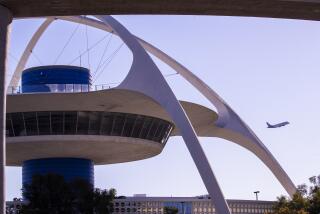51 Near-Misses of Aircraft Over L.A. in Year Set Mark
A record 51 near-collisions between aircraft have been reported over the Los Angeles Basin in the last 12 months, more than triple the number of the previous year and more than anywhere else in the nation, Federal Aviation Administration officials said Thursday.
Jim Holweger, the FAA’s regional air traffic control manager, announced the tally of near-misses reported between Aug. 1, 1986, and Aug. 1, 1987, at a news briefing in Hawthorne where he explained why the FAA decided to issue an emergency order Wednesday that expands the controlled airspace over Los Angeles.
Holweger said 14 near-collisions were reported over Los Angeles between Aug. 1, 1985, and Aug. 1, 1986.
The high number of near-misses in Los Angeles reflects the fact that the skies here are the most congested in the nation, Holweger said. FAA records show that there are 27,000 licensed pilots--commercial and general aviation--in Los Angeles County alone.
In addition, traffic at Los Angeles International Airport, the third-busiest airport in the country, was up 20% for the first six months of this year over last year, Holweger said.
He said that the emergency order issued by FAA Administrator T. Allan McArtory is “a matter of FAA responsibility to ensure the safety of the flying public, whether it be airline passenger or pilot of a small airplane.”
The emergency order raises the ceiling of the airport’s Terminal Control Area (TCA), airspace primarily set aside for commercial jetliners, from 7,000 feet to 12,500 feet. It also closes a coastal “visual flight corridor” that had been created by the FAA to allow private planes to fly through the TCA in good weather.
The order, which goes into effect Wednesday, will force airplanes flying by visual rules--most light aircraft--into low corridors beneath the easterly tiers of the TCA surrounding Los Angeles International in the vicinity of Whittier and other eastern Los Angeles County suburbs.
FAA officials said the emergency order was the first change in the Los Angeles TCA since 1971.
The president of a powerful lobbying group representing private and corporate aviation said Thursday that his organization intends to contest the order, possibly in the courts.
“It’s obvious we have a war on our hands,” said John L. Baker, who heads the 260,000-member Aircraft Owners and Pilots Assn., which for years has successfully staved off proposals to restrict private aviation in favor of the airline industry.
Vows to Fight
“This is it. We’re fighting down the line on this from here on out,” he said.
Baker called the FAA rule “a classic case that you find in Washington so often of someone doing something, even when it is wrong, to give the appearance of being on top of the problem.”
Of particular concern to some private pilots was the closing of the visual flight corridor. Some “pleasure” pilots said they may fly less frequently because it would cost them more to fly further east to comply with the new TCA.
There are no precise figures on how many pilots use the corridor, but federal aviation officials believe that more than 100 flights go through the corridor each day.
FAA officials conceded Thursday that they face a “massive job” in trying to inform pilots about the emergency order. FAA spokesman Russell Park said the agency in the next few days plans to:
- Post notices at agency flight service stations, area airports and other places where pilots must check in for flight data and information.
- Mail a special notice to about 50,000 pilots informing them of the changes.
- Establish a special automated message that will be broadcast repeatedly on certain radio frequencies for pilots approaching the Los Angeles TCA.
FAA officials said the emergency order could remain in effect as long as a year or be superseded by any permanent changes made by federal officials.
Russ Park, an FAA spokesman in Los Angeles, said the agency is exploring the possibility of expanding terminal control areas at 22 airports. Lindbergh Field in San Diego and McCarran International in Las Vegas are among the airports.
Meanwhile, officials at the Los Angeles field office of the National Transportation Safety Board continued their investigation of a near-collision Tuesday in which an American Airlines 737 jetliner made a violent left turn and dived to avoid an unidentified small plane that came within 100 feet of it.
NTSB officials said an analysis of computer data of the incident has not yet been completed.
FAA officials said Wednesday that it appeared that neither aircraft was in violation of airspace rules. The American pilot reported he was at 7,400 feet--above the current TCA ceiling--when the incident occurred.
More to Read
Sign up for Essential California
The most important California stories and recommendations in your inbox every morning.
You may occasionally receive promotional content from the Los Angeles Times.










